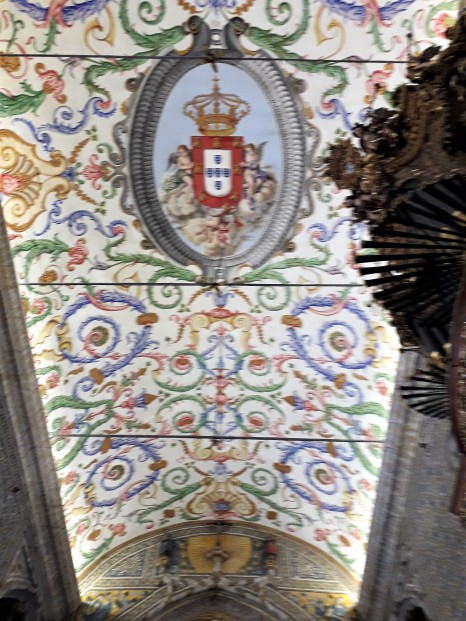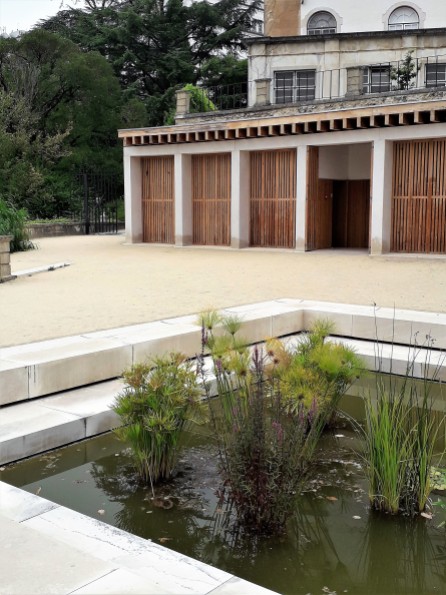Central to the University of Coimbra lies a vast square, looking down from which you have the city at your feet. To reach it you have a steady climb, up through winding streets. On a fine day, a magnificent view will be your reward. Sadly, our skies were grey and misted with a fine drizzle, but we were celebrating a birthday and determined to enjoy it. A 45 minute train ride had brought us here, from Aveiro, out on the coast.
In Roman times Coimbra was known as Aeminium. An aqueduct and traces of mosaic discovered in this area date back 2,000 years. The first Muslim occupation of the Iberian peninsula took place between 711 and 715, and Coimbra surrendered in 714. Many of the street names survive from that period, and the alcáçova, or fortified palace, where the governor of the city lived, formed the basis of the Royal Palace of the first kings of Portugal. During this time the high part of town was walled and fortified. Coimbra was reconquered by the Christians permanently in 1064, becoming the capital of the first Portuguese dynasty, in the ever complicated history of this country, in 1131. It remained so until 1255, when the seat of power was transferred to Lisbon.
It was almost by chance that we came upon the Sé, or Old Cathedral, in Largo da Sé Velha. Built in the Romanesque style, on the site of a temple dedicated to Santa Maria, from the outside the cathedral resembles a small fortress. Steep steps lead to the main portal, beyond which a hush descends. My eyes alighted on huge seashells, the like of which I had never seen. Labels proclaim them Tridacma shells, from the Indian Ocean. The alcoves on either side of the nave feature compelling spotlit portraits, while the walls gleam with 16th century edged Múdejar tiles from Seville.
The Gothic cloister, begun around 1218, is the oldest in Portugal. Unintentionally it’s a green space for small children at play. Leaving the cathedral, it’s an upwards slog to the University complex. Robed nuns paid us scant attention, going about their business within the solid walls.
If I knew anything at all about Coimbra it was that the University was beautiful, and had been designated a UNESCO World Heritage site in 2013. Founded in Lisbon by King Dinis, in 1290, it alternated between the two cities till it was definitively established in Coimbra in 1537. It is one of the oldest in Europe, and was the only one in the Portuguese-speaking world until 1911. The life of the city revolves around the state-run university.
We purchased a composite ticket for the Palace and the Joanine Library. The latter had to be viewed on a specific time slot so we headed first to St. Michael’s Chapel, where we gaped upwards at the painted, arched ceiling and astounding baroque organ. Just time for a coffee before descending the Minerva stairs to patiently await our turn.
Finally we were shepherded into cool chambers with dense walls and arched ceilings, not quite sure at what tomes we were looking. This was just a preliminary. The gasps came later. With over 200,000 books, mostly in Latin and pre-18th century, the Joanine Library (named for King Joáo V) is recognised as the most sumptuous university library ever made. The 72 shelves, arranged over 2 floors in 3 rooms, are minutely decorated with Chinese motives. I had thought the library in Trinity College, Dublin amazing, but this one defied description. Nor were we allowed to take photos, conservation being necessarily important. The books have an unusual ally- a colony of bats who entertain themselves at night by feasting on wayward insects. This was one of those occasions when I was glad I’d purchased a full colour souvenir brochure. As I explained last week, I’ve lost all except one of my photos from this visit to Coimbra. I’ve used my husband’s photos throughout this post, but I managed to find a video to give you a brief glimpse inside the library. It barely does it justice.
Still awed at what we’d seen, we continued around the Palace and out onto the balcony for misty views down to the river. During the Middle Ages Coimbra was divided into an upper city, where the clergy and aristocracy lived, and a lower city for merchants, artisans and labourers, down beside the River Mondego. Since 1772, the Botanical Garden has wrapped a green cloak around the skirts of the city, combining the beauty of nature with education and research.
A cobbled path leads from the rear of the gardens down to the riverside, where fountains play majestically across the water, reminding me of Geneva. A footbridge spans the river, and playing fields line its banks. We crossed to the far shore to look back at the city, before returning to the station. Take a more comprehensive look at Coimbra, with Julie Dawn Fox. She lives not far away, and has many suggestions for walking throughout Portugal, too. And incidentally, if you can’t face the climb, there is a bus that will take you up to the University grounds.

Not so many walks this week. People are busy with Christmas preparations. I hope to have another Jo’s Monday walk next week but I’ll understand if you can’t join me. Even though I promise to bring cake!
…………………………………………………………………………………….
Janet made me smile with this title and I’ve been singing it ever since!
Drake always makes me smile! You will love this burst of heat and colour :
Much more subtle colour from Georgina, tempting me across the border into Spain :
Autumn Walks in the Sierra Aracena
A nice bit of variety, and some daily exercise, with Yvette :
Photos from Daily Walks (2020 Countdown 13 of 31)
And a truly beautiful bit of night photography from Becky :
While Cathy finally completes her journey :
(Camino day 47) Pedrouzo to Santiago
Wishing you all a great week! We have a rainy forecast here so there will be some delighted skipping in puddles.













I may be lured back to Portugal 😉
LikeLike
Good plan! I know someone with a great spare room 🙂 🙂
LikeLike
Fascinating post Jo – I wonder how anyone manages to find a book in that library it is so impressive?! xx
LikeLike
No idea where to start! Merry Christmas darlin. At James home 🤗🎅🎄🎁🥂💕
LikeLiked by 1 person
Enjoy! Xx 🍸🎅🎄😃
LikeLiked by 1 person
Looks beautiful Jo!
LikeLike
A lovely city, Nicole 🤗💕
LikeLike
We visited Coimbra a few weeks ago too. 🙂
We had a sunny but cold day.
Nice city. 🙂
Soon, some posts about that trip.
LikeLike
The University and Cathedral are beautiful. Unfortunately I lost all my photos, but I have the memories 🙂 🙂
LikeLiked by 1 person
Wow, what a situation! 😦
Yes, my girlfriend studied at Coimbra, so it was her idea to show me the city and the university. 🙂
It was really great.
At least you keep in mind the memories. 🙂
LikeLiked by 1 person
Your architecture is so hugely different for what we find around here. I bet you’re having fun exploring it.
LikeLike
It’s become home, Gunta, with all its quirks and characteristics. I love it 🙂 🙂
LikeLike
culture rich beauty indeed – great place to walk Jo
LikeLike
It wasn’t what we planned to do, Yvette, but it was a great day 🤗💕
LikeLiked by 1 person
😊
LikeLiked by 1 person
I shall have to go back and re-read this piece, Jo, as Christmas is catching up with me. It looks a stunning place and I look forward to absorbing more of it when I get a few minutes to spare. Meantime, have a lovely Christmas.
LikeLike
Bless you, hon! Have a lovely Christmas too 🙂 🙂
LikeLike
Magnificent! That is a fabulous walk. Thank you for the tour, Jo!
LikeLiked by 1 person
It’s a beautiful city, Amy. The library was astonishing 🙂 🙂 Thanks for walking with me.
LikeLiked by 1 person
I have only seen Coimbra from the train! Maybe 2020 is the year we finally visit . . .
LikeLike
PS thank you for the lovely link up xx
LikeLike
You’re very welcome! All ok with you? 🙂 🙂
LikeLiked by 1 person
Yes, just juggling lots. Had a lovely few days with Mum, now festival work to do before preparing for Christmas!
LikeLiked by 1 person
Merry Christmas to Mum! 🙂 🙂
LikeLiked by 1 person
It’s a city you’d love, Becky. So rich in history! 🙂 🙂
LikeLiked by 1 person
Will definitely go . . . 🙂
LikeLiked by 1 person
We visited the university when we were in Portugal about 7 years ago & like you, were absolutely in awe of its beauty! Absolutely stunning!
LikeLike
Hello Lynn 🙂 🙂 Hope your Christmas preparations are going well, and you’ve settled in the new job? Have a wonderful family time this Christmas, and I’ll hope to see you in the New Year 🙂 🙂
LikeLike
The ceiling is simply beautiful and I wonder how the artists managed to work at such a height. I have a walking post scheduled to publish on the weekend, with a link to this post. 🙂
LikeLike
The library ceilings were beautiful too, and I have no idea how you can achieve it either, Carol! Thanks so much- I’ll look out for it 🙂 🙂
LikeLiked by 1 person
Beautiful place.
LikeLike
I had intended to spend a few days there, but we were so close when we stayed in Aveiro, it seemed a shame not to take a look. 🙂 🙂
LikeLike
thank you so much for bringing me back to Coimbra, Jo. it is a beautiful city and i thoroughly enjoyed our visit. i have similar shots of your several pictures. what a delightful post! 🙂
LikeLike
The University complex is special, isn’t it, LolaWi? 🙂 🙂 The library silenced me (and that takes some doing 🙂 )
LikeLike
my most memorable experience in Coimbra was the university complex and the Johannine Library. truly special! 🙂
LikeLiked by 1 person
What a beautiful place – clearly very wealthy back in the day!
LikeLike
When it was the capital of Portugal I imagine lots of money was spent on it, Emma, but all these years on it seems to’ve been money well spent 🙂 🙂
LikeLiked by 1 person
That explains all the beautiful buildings!
LikeLiked by 1 person
What an absolutely stunning place. It does make the “new world” universities I’m accustomed to seem very utilitarian.
LikeLike
Our local University used to be Durham, Su, and that was very classy too but not a patch on this place. 😇💕
LikeLike
Very inspiring walk. 🙂
Bad weather is a myth. 😀
LikeLike
Lots of ‘weather’ arrived yesterday, Drake, but we needed it 🙂 🙂
LikeLiked by 1 person
Of course all is quite impressive, but I’d be in my glory with that incredible library. It’s quite grand, yet that word hardly describes it! 😉
LikeLike
I stood and just gaped, Debbie! The reality is so much larger than life. The richness of colour hard to describe, from beautifully painted ceilings to floor. I could have sat on a chair and just looked, but naturally it was forbidden to touch anything 😦 😦 How are you hon?
LikeLike